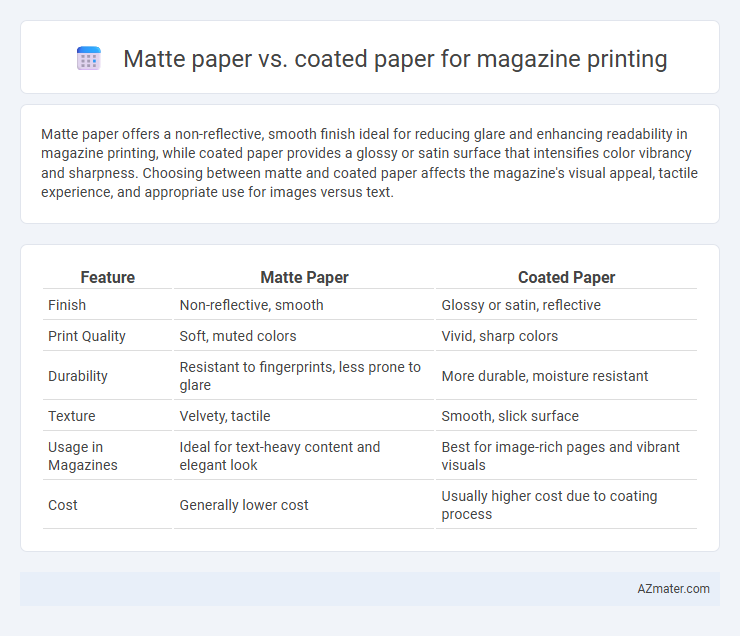Matte paper offers a non-reflective, smooth finish ideal for reducing glare and enhancing readability in magazine printing, while coated paper provides a glossy or satin surface that intensifies color vibrancy and sharpness. Choosing between matte and coated paper affects the magazine's visual appeal, tactile experience, and appropriate use for images versus text.
Table of Comparison
| Feature | Matte Paper | Coated Paper |
|---|---|---|
| Finish | Non-reflective, smooth | Glossy or satin, reflective |
| Print Quality | Soft, muted colors | Vivid, sharp colors |
| Durability | Resistant to fingerprints, less prone to glare | More durable, moisture resistant |
| Texture | Velvety, tactile | Smooth, slick surface |
| Usage in Magazines | Ideal for text-heavy content and elegant look | Best for image-rich pages and vibrant visuals |
| Cost | Generally lower cost | Usually higher cost due to coating process |
Introduction to Magazine Paper Types
Matte paper offers a non-glossy, smooth finish that reduces glare and enhances readability, making it ideal for text-heavy magazine content. Coated paper features a shiny or semi-gloss surface that improves color vibrancy and image sharpness, optimizing visual appeal for photo-centric magazines. Choosing between matte and coated paper depends on the desired aesthetic, print quality, and reader experience in magazine production.
What is Matte Paper?
Matte paper features a non-glossy, flat finish that reduces glare and provides a smooth, soft texture ideal for easy readability in magazine printing. This type of paper absorbs ink well, enhancing color depth and sharpness while minimizing fingerprints and smudges. Matte paper is commonly chosen for editorial content and photography that require a sophisticated, understated look without reflective shine.
What is Coated Paper?
Coated paper is treated with a surface coating that enhances brightness, smoothness, and ink holdout, making it ideal for magazine printing where vibrant, sharp images are essential. This coating typically consists of a mixture of clay, latex, or other compounds, providing a glossy or satin finish that improves color saturation and detail. Compared to matte paper, coated paper reduces ink absorption, resulting in sharper text and more dynamic photographs, crucial for high-quality magazine layouts.
Visual Differences: Matte vs. Coated Paper
Matte paper offers a non-reflective, smooth surface that reduces glare and provides a soft, subdued appearance ideal for text-heavy or artistic magazine pages. Coated paper features a glossy or satin finish that enhances color vibrancy and sharpness, making images and photographs appear more vivid and detailed. The choice between matte and coated paper significantly impacts the visual appeal and readability of magazine content.
Print Quality and Color Vibrancy
Matte paper offers a non-reflective finish that reduces glare, resulting in softer print quality and muted color vibrancy ideal for text-heavy magazines prioritizing readability. Coated paper, with its glossy or satin surface, enhances print sharpness and color intensity, producing vivid, eye-catching images that appeal to visual-centric publications. Choosing between matte and coated paper significantly impacts the overall appearance and engagement level of magazine content through variations in print clarity and color saturation.
Reader Experience and Tactile Feel
Matte paper offers a smooth, glare-free surface that enhances readability by reducing light reflection, providing a comfortable reading experience for magazine audiences. Coated paper features a glossy or satin finish that intensifies colors and sharpens images, delivering vibrant visuals that engage readers more visually but may cause glare under bright lighting. The tactile feel of matte paper is velvety and soft, creating a premium, understated touch, while coated paper feels slick and polished, conveying a sense of high-quality vibrancy but less warmth in hand.
Durability and Smudge Resistance
Matte paper offers moderate durability with a non-reflective finish that minimizes glare, but it is more prone to smudging compared to coated paper. Coated paper, especially with a glossy or satin finish, provides higher durability due to its sealed surface, which resists smudges and fingerprints effectively. For magazine printing, coated paper is preferred when smudge resistance and vibrant image quality are critical, while matte paper suits publications seeking a subdued, elegant appearance with moderate handling.
Cost Comparison: Matte vs. Coated Paper
Matte paper typically costs less than coated paper due to its simpler manufacturing process and lower gloss finish, making it a budget-friendly option for large-scale magazine printing. Coated paper, with its smooth and glossy surface, demands higher production expenses but enhances image vibrancy and sharpness, which can justify the increased cost in premium publications. Publishers often weigh the cost-efficiency of matte paper against the superior print quality of coated paper when planning magazine print runs and budgets.
Sustainability and Environmental Impact
Matte paper for magazine printing typically offers better sustainability due to its lower chemical coating levels, resulting in easier recyclability and reduced environmental harm compared to heavily coated paper. Coated paper often involves extensive chemical treatments and non-biodegradable finishes that can complicate recycling processes and increase carbon footprint. Choosing matte paper supports eco-friendly printing practices by minimizing toxic waste and enabling more effective post-consumer recycling.
Choosing the Right Paper for Your Magazine
Matte paper offers a non-reflective surface that enhances readability and provides a sophisticated, subdued look ideal for editorial content, while coated paper delivers vibrant color reproduction and sharp images, making it perfect for magazines with striking visuals. The choice between matte and coated paper impacts the magazine's aesthetic appeal, durability, and printing cost, with matte paper often being more budget-friendly yet less glossy than coated alternatives. Understanding your magazine's target audience and content style helps determine the best paper type to balance visual impact and tactile experience effectively.

Infographic: Matte paper vs Coated paper for Magazine printing
 azmater.com
azmater.com